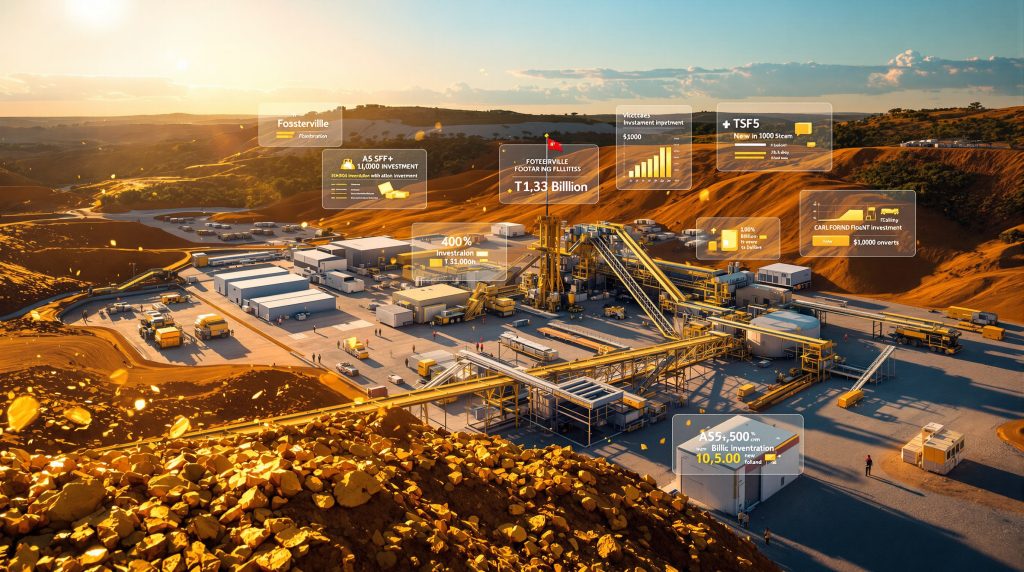Understanding Victoria's Landmark Tailings Facility Approval
The recent approval of new tailings approved for Victoria's biggest gold mine represents a watershed moment for Australian gold mining operations. This decision extends the operational lifespan of one of the nation's most productive gold mines while establishing new precedents for sustainable resource development in environmentally sensitive regions.
The 23-hectare TSF5 facility secures employment for over 1,000 workers and positions Victoria to maintain its leadership in Australia's gold sector. With projections indicating A$1.3 billion in regional economic injection over the next decade, this approval demonstrates how modern mining operations can balance commercial viability with rigorous environmental stewardship.
Technical Infrastructure and Processing Capabilities
The newly approved TSF5 facility incorporates advanced engineering systems designed to optimise waste management while supporting increased processing throughput. Located within Fosterville's existing operational footprint, the facility utilises sophisticated flotation and neutralisation technologies to manage tailings from gold extraction processes.
Key Engineering Specifications:
• Footprint: 23 hectares within existing mine boundaries
• Integration: Seamless connection with existing TSF1 and TSF4 facilities
• Technology: Advanced flotation systems and pH neutralisation processes
• Capacity: Designed to support approximately one decade of operations
• Processing Enhancement: Enables increased ore throughput and improved waste storage efficiency
The facility's design represents current best practices in tailings management, incorporating water recycling systems and environmental monitoring protocols. Furthermore, modern mine planning processes ensure the integration with existing infrastructure creates operational efficiencies while reducing the overall environmental footprint compared to standalone facility development.
Modern tailings storage facilities require sophisticated geotechnical engineering to ensure long-term stability and environmental protection. The TSF5 design incorporates embankment stability monitoring, seepage control systems, and dust suppression technologies to meet Victoria's stringent environmental standards.
Victoria's Environmental Assessment Framework
The approval process showcased Victoria's comprehensive Environment Effects Statement framework, which examined potential impacts across multiple environmental domains. This rigorous assessment evaluated groundwater and surface water quality, air emissions management, biodiversity protection, community noise impacts, and cultural heritage considerations.
Assessment Categories Examined:
• Water Resources: Groundwater monitoring networks and surface water quality protection
• Air Quality: Dust generation modelling and suppression technologies
• Biodiversity: Flora and fauna impact assessment with offset strategies
• Community Impact: Noise management and visual landscape considerations
• Cultural Heritage: Indigenous cultural site protection and consultation processes
The EES framework requires comprehensive mitigation strategies for identified environmental risks. In addition, approved safeguards include advanced water treatment systems, real-time environmental monitoring, and ongoing compliance reporting to regulatory authorities.
The approval demonstrates that potential environmental impacts can be effectively managed through appropriate engineering safeguards and monitoring protocols.
Victorian Energy and Resources Minister Lily D'Ambrosio emphasised that the approval process validated the state's capacity to balance resource development with environmental protection. However, the implementation of comprehensive waste management solutions ensures mining operations contribute positively to regional communities while maintaining ecological integrity.
Regional Employment and Economic Impact
The TSF5 approval secures employment for more than 1,000 regional workers, including 650+ full-time personnel and 200 contractors. This employment stability provides crucial economic security for families throughout the Bendigo region, with most workers residing locally within the mining community.
Employment Characteristics:
• Direct Employment: 650+ full-time positions
• Contractor Roles: 200 specialised contractor positions
• Local Workforce: Majority residing within Bendigo region
• Economic Multiplier: A$1.3 billion regional injection over 10 years
• Workforce Development: Ongoing apprenticeship and training programmes
The employment security extends beyond direct mining positions to support local business ecosystems, including accommodation, retail, professional services, and equipment suppliers. Member for Bendigo West Maree Edwards characterised the approval as securing the livelihoods of hundreds of regional workers while maintaining Bendigo's economic foundation.
Regional economic multiplier effects from large-scale mining operations typically generate 2-3 additional jobs in supporting industries for every direct mining position. Consequently, this multiplier effect strengthens local business confidence and supports long-term community development initiatives.
Global Significance and Production Context
Fosterville's continued operations maintain Australia's position as the world's second-largest gold producer, accounting for approximately 8-9% of global gold production annually. Australia's gold mining sector generated AUD $11.3 billion in export revenue during 2023-24, with Victorian operations contributing substantially to this total.
| Performance Metric | Fosterville Contribution | Australian Context |
|---|---|---|
| State Production | Victoria's largest operating mine | Victoria leads Australian states |
| Grade Quality | Among world's highest-grade operations | Top-tier global producer |
| Employment | 850+ direct workers | Significant regional employer |
| Economic Impact | A$1.3B over 10 years | Major export revenue contributor |
Victoria remains Australia's largest gold-producing state, with historical production exceeding 70 million ounces since the 1850s gold rush. This legacy provides established regulatory frameworks, skilled workforce availability, and community acceptance that supports continued mining development.
The approval occurred during a period of record-high gold prices, strengthening the investment case for continued operations and expansion. For instance, the current gold investment outlook remains positive due to ongoing economic uncertainties, making operational security through extended facility approvals particularly valuable for long-term planning.
Modern Tailings Management Best Practices
Contemporary tailings storage requires sophisticated engineering to prevent environmental contamination while maximising resource recovery. The TSF5 design incorporates multiple barrier systems, including engineered liners, monitoring networks, and water treatment facilities to ensure long-term environmental protection.
Critical Management Components:
• Geotechnical Stability: Engineered embankments with ongoing stability monitoring
• Water Management: Recycling systems and treatment protocols
• Environmental Protection: Groundwater monitoring and contamination prevention
• Long-term Security: Closure planning and post-mining rehabilitation strategies
Modern tailings facilities utilise advanced flotation processes to separate valuable minerals from waste rock, reducing the volume of material requiring storage. Furthermore, neutralisation processes prevent acid mine drainage by adjusting pH levels, protecting downstream water resources from contamination.
The integration of TSF5 with existing facilities demonstrates staged development approaches that optimise water recycling, reduce operational costs, and distribute environmental risks across multiple containment systems. These mine reclamation innovations represent industry best practice for long-life mining operations.
Strategic Positioning Within Victoria's Mining Policy
The approval reinforces Victoria's commitment to maintaining its 170+ year gold mining heritage while adapting to contemporary environmental standards. This balance demonstrates how established mining jurisdictions can evolve regulatory frameworks to support both resource development and environmental stewardship.
Policy Alignment Benefits:
• Resource Development: Supports continued extraction of world-class mineral deposits
• Environmental Stewardship: Demonstrates rigorous assessment and mitigation protocols
• Community Benefit: Maintains regional employment and economic stability
• Investment Attraction: Provides regulatory certainty for mining sector investment
Victorian Premier Jacinta Allan positioned the approval as showcasing Victoria's world-class resources while attracting international investment and creating local employment opportunities. This messaging emphasises Victoria's competitive positioning in global mining markets.
The approval establishes benchmarks for future mining project assessments throughout Australia, demonstrating pathways for securing expansion approvals while maintaining environmental compliance. However, these precedents influence industry confidence and investment decision-making across the broader mining sector.
Investment Implications and Market Analysis
The tailings facility approval removes critical operational constraints that could have limited Fosterville's production continuity. This regulatory certainty enhances investment attractiveness and supports long-term strategic planning for mining operations and supporting infrastructure.
Investment Considerations:
• Operational Certainty: Decade-long waste storage capacity secured
• Regulatory Compliance: Comprehensive environmental approvals reduce risk
• Production Continuity: Eliminates potential operational bottlenecks
• Market Positioning: Maintains competitive advantage in high-grade gold production
The approval occurred during elevated gold price periods, improving operational economics and supporting capital investment decisions. Gold mining operations require substantial upfront infrastructure investments that depend on long-term operational security for financial viability.
Resources Victoria's approval provides regulatory stability that supports equipment procurement, workforce planning, and operational optimisation initiatives. Consequently, this stability enables mining operators to implement efficiency improvements and technology upgrades with confidence in long-term operational continuity.
Future Implications for Australian Mining Development
The Fosterville approval demonstrates successful integration of economic development objectives with environmental protection requirements. This achievement establishes models for how future mining projects can secure necessary expansion approvals while maintaining rigorous environmental standards.
Industry-Wide Precedents:
• Assessment Standards: Establishes benchmarks for environmental impact evaluation
• Mitigation Protocols: Demonstrates effective safeguard implementation
• Community Engagement: Shows pathways for stakeholder consultation and approval
• Technology Integration: Validates advanced processing and monitoring technologies
The decision reinforces Australia's mining sector competitiveness while establishing sustainable development frameworks for future resource projects. These frameworks balance economic opportunity creation with environmental responsibility, supporting both industry development and community acceptance through sustainable mining practices.
Disclaimer: The economic projections and employment figures cited reflect official government announcements and should be considered alongside broader economic conditions and gold market volatility. Mining operations involve inherent risks including commodity price fluctuations, regulatory changes, and operational challenges that may affect actual outcomes.
Key Considerations for Stakeholders
The TSF5 approval represents successful demonstration of how modern mining operations can secure expansion approvals through comprehensive environmental assessment and community engagement. This balanced approach creates value for multiple stakeholder groups while maintaining operational and environmental integrity.
For government stakeholders, the approval demonstrates effective regulatory frameworks that support resource development while protecting environmental assets. The process validates Victoria's capacity to attract mining investment through clear, rigorous approval pathways.
Community stakeholders benefit from secured employment, economic stability, and demonstrated environmental protection through comprehensive monitoring and mitigation requirements. The local workforce emphasis ensures economic benefits remain within regional communities.
Industry stakeholders gain regulatory certainty and operational models for future project development. The successful approval process provides templates for environmental assessment, community engagement, and technology implementation that can inform broader sector development.
This comprehensive approach to mining development approval establishes foundations for sustainable resource sector growth that balances economic opportunity with environmental stewardship and community benefit.
Looking to Capitalise on Mining Discoveries?
Discovery Alert delivers instant notifications on significant ASX mineral discoveries using its proprietary Discovery IQ model, transforming complex geological announcements into actionable investment insights. Secure your market advantage by exploring major discovery opportunities and begin your 30-day free trial today to stay ahead of the competition.




